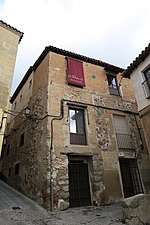Church of San Miguel el Alto, Toledo
12th-century Roman Catholic church buildings in SpainBien de Interés Cultural landmarks in the Province of ToledoChurches in Castilla–La ManchaKnights TemplarMudéjar architecture in Castilla–La Mancha ... and 2 more
Roman Catholic churches in Toledo, SpainSpanish church stubs

The Iglesia de San Miguel el Alto is a building of medieval origin located in Toledo (Castile-La Mancha, Spain). Dedicated to St Michael, the church served one of the old Latin parishes of the city, but is now part of the parish of San Justo. It appears that it also had some relation to the Knights Templar who are believed to have had a guest-house in Toledo. The original 12th century building was extensively remodelled in the 17th century by Juan Bautista Monegro, but retains some Mudejar features, notably its tower from around the end of the 13th century.
Excerpt from the Wikipedia article Church of San Miguel el Alto, Toledo (License: CC BY-SA 3.0, Authors, Images).Church of San Miguel el Alto, Toledo
Paseo Corralillo de San Miguel, Toledo Santa Bárbara
Geographical coordinates (GPS) Address External links Nearby Places Show on map
Geographical coordinates (GPS)
| Latitude | Longitude |
|---|---|
| N 39.8567 ° | E -4.02 ° |
Address
Iglesia de San Miguel
Paseo Corralillo de San Miguel
45002 Toledo, Santa Bárbara
Castile-La Mancha, Spain
Open on Google Maps










